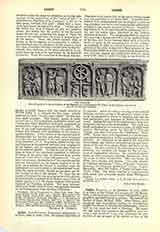

Labbe, PHILIPPE, b. at Bourges, July 10, 1607; d. at Paris, at the College of Clermont, 17 (16) March, 1667, a distinguished Jesuit writer on historical, geographical, and philological questions. He entered the Society of Jesus, September 28, 1623. After literary, philosophical, and theological studies, he successively taught the classes of rhetoric and philosophy; then he held for five years the chair of theology. His memory was quick and retentive, his erudition most extensive and accurate; every year witnessed the production of one or more of his works, so that in the field of history Labbe and Petavius have been considered as the most remarkable of all French Jesuits. After his death it was found that his notes and annotations on all kinds of authors were so numerous and extensive as to exceed in bulk what an ordinary savant reads during his lifetime. A great deal of time was taken up answering the doubts or questions of others; he was constantly consulted on points of history, on questions of literature, on difficulties in moral and scholastic theology. However, he found time to express his devotion to Christ and His Blessed Mother in elegant Latin verse. His biographers emphasize his tender devotion to the Holy Eucharist and the Blessed Virgin.
Sommervogel enumerates more than eighty works left by Labbe, but we have to be satisfied with the titles of only the more important ones. (I) Among the works on philological subjects, we may mention: “Tirocinium Linguae Graecae, etc.”, Paris, 1648. The work went through some thirteen or fourteen editions. Labbe had the annoying habit of modifying the titles of his works in their various editions, so that a list of their complete titles is quite impossible here. (2) “La Geographic royale” appeared first in Paris, 1646. (3) “De Byzantine historiae scriptoribus, etc.” (Paris, 1648), was valued as a most useful work at the time of its publication. (4) “Concordia sacrae et profanae chronologiae annorum 5691 ab orbe condito ad hunt Christi annum 1638” (Paris, 1638); the author published several other harmonies of historical dates, which contained a number of dissertations on special questions. (5) “Bibliotheca antijanseniana” (Paris, 1654), is a catalogue of all writings directed against the Jansenists, and gives a brief history of the origin of Jansenism. (6) “Bibliotheca bibliothecarum” (Paris, 1664), a bibliography for the handy use of librarians. The second edition of this work contains an additional part entitled “Bibliotheca nummaria”, and describes old medals, coins, weights, measures, and other antiquarian objects. (7) “Sacrosancti Oecumenici Tridentini Concilii. canones et decreta” (Paris, 1667), is a work containing a great number of documents referring to secular princes and their repsentatives in the council, and giving also some of the conciliar transactions. (8) But the chief work is the collection of councils entitled “Sacrosancta concilia ad regiam editionem exacta”, published by the joint labor of Labbe and Cossart, and printed in Paris at the expense of the Typographical Society for Ecclesiastical Books. When Labbe died, the vols. I-VIII and XII-XV had been printed; vols. IX and X were in press; Cossart finished these two volumes and also vol. XI. In the sixteenth volume (or the seventeenth, for XI is a double volume) the “apparatus” of the collection has been added by Cossart. A second “apparatus” has been added in vol. XVIII, which contains the treatise “De conciliis” by Jacobatius; but this volume is extremely rare and expensive, the price being as high as that of the rest of the collection.
A. J. MAAS

